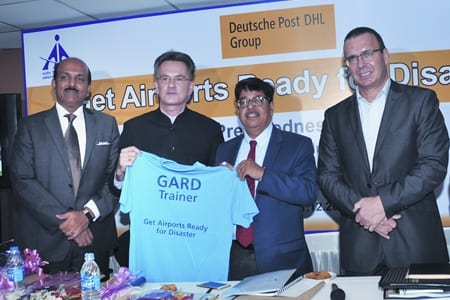G(u)ARDing against disaster
For the very first time in India, the Get Airports Ready for Disaster (GARD) programme was organised by Deutsche Post DHL Group and UNDP at Guwahati International Airport. RS Subramanian, senior VP & country manager, DHL Express, India explains what the programme entails and why the North Eastern gateway was chosen as the first Indian airport for the workshop By Sudipta Dev
Get Airports Ready for Disaster (GARD) programme prepares airports in disaster prone areas to better handle the surge of incoming relief goods. Introduced in 2009 by United Nations Development Programme (UNDP) and Deutsche Post DHL Group, so far GARD has been adapted at 30 airports worldwide. In December 2015, it was organised at Lokpriya Gopinath Bordoloi International Airport, Guwahati with support of Airport Authority of India. “The workshop covers group exercises, airport assessment and airport report writing. Participants at the training include airport authorities and staff who manage the operations, logistics and are responsible for seamless coordination, as well as representatives from international organisations (such as WPF) and disaster management,” says RS Subramanian, senior VP and country manager, DHL Express, India.
There are many factors why Guwahati was chosen as the first airport in India for this programme. While the airport was nominated by the AAI, Subramanian points out that India’s North East region is among the most seismically active region and considered as the sixth major earthquake-prone belt in the world. “Guwahati being the gateway to the North East India is the nerve centre for evacuation of people and arrival of relief material during a calamity. Thus, it was necessary to conduct the training in this particular airport before the programme moves to other airports in India,” he adds. Interestingly, Patna is the next location nominated by the Airport Authority of India for the GARD programme.
The achievable aims of the training includes developing a blue print for the region and the airport in terms of response procedures to be followed for increased efficiency at an airport in times of a calamity. According to Subramanian, the training also aims to make airport authorities and staff efficient in their response to provide relief and supplies to residents of the affected areas. “It also determines surge capacity assessment criteria that can be applied to that particular airport. A structured report is compiled on the airport’s surge capability and management structure in order to have a streamlined process,” he states.
Acknowledging that India as a country has a robust disaster recovery plan, Subramanian mentions, “Our role as one of the leading players in international express, is to help enable airport staff to reach the levels of proficiency required to execute those plans. What is needed is a common understanding among all parties involved in disaster management in the country. The GARD programme helps facilitate the process so that all parties are well aware of their individual roles and responsibilities which will result in a more seamless approach through the three different phases – disaster preparedness, response and recovery.” The recommendation is to leverage the knowledge of the private sector which has expertise in this area and integrate a set of well-defined logistic capabilities. “Overall the aim is to facilitate smooth operations between all parties during an unavoidable natural disaster,” asserts Subramanian.
The participants were a mix of staff from the airport’s terminal management team, including cargo handling, operations, communications, navigation services, electric, civil and electric engineering, fire and security services, immigration, customs and district officials. Organisations involved in disaster relief like the National Disaster Management Authority, Assam State Disaster Management Authority, the Indian Air Force and the International Organisation for Migration also participated in the workshop.
GARD programme has been organised so far at airports of following countries – Indonesia (2009, 2011 and 2012), Nepal (2010), Bangladesh (2011), Lebanon, Turkey (2012), El Salvador, the Philippines, Panama and Armenia (2013), Peru (2014) and Sri Lanka (2014).


